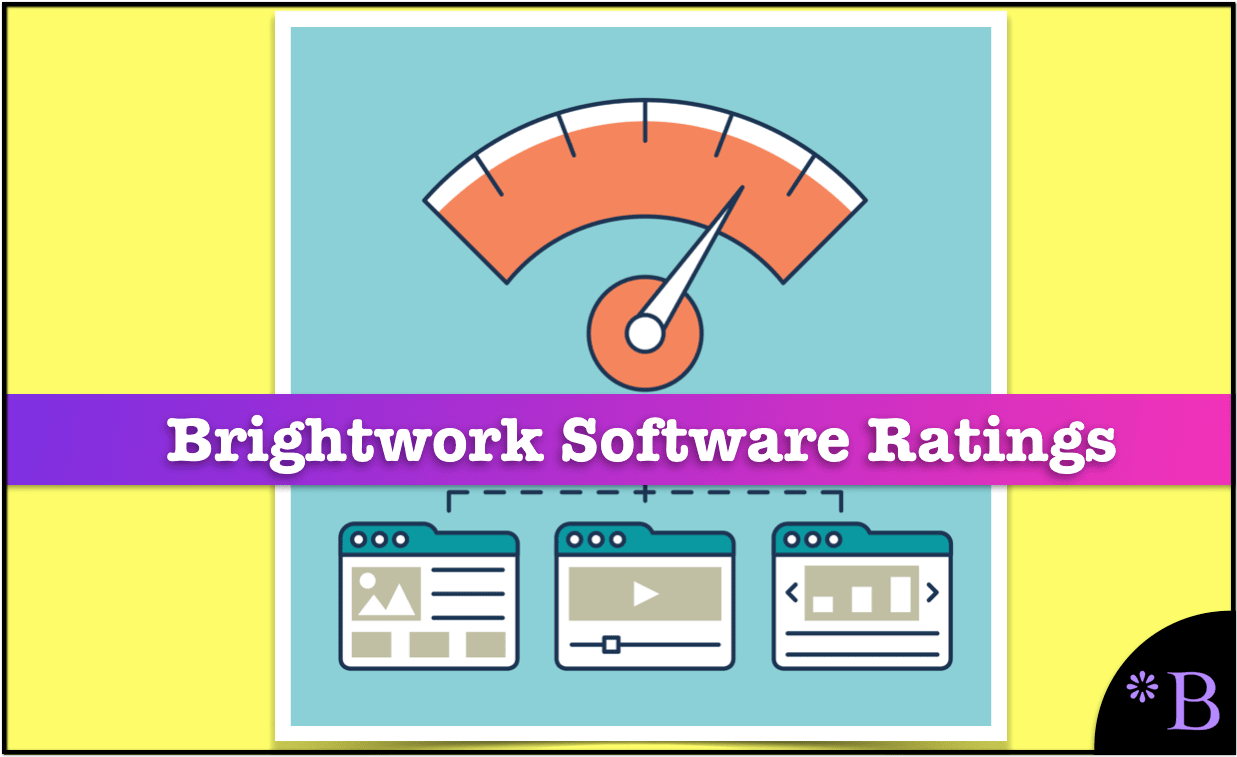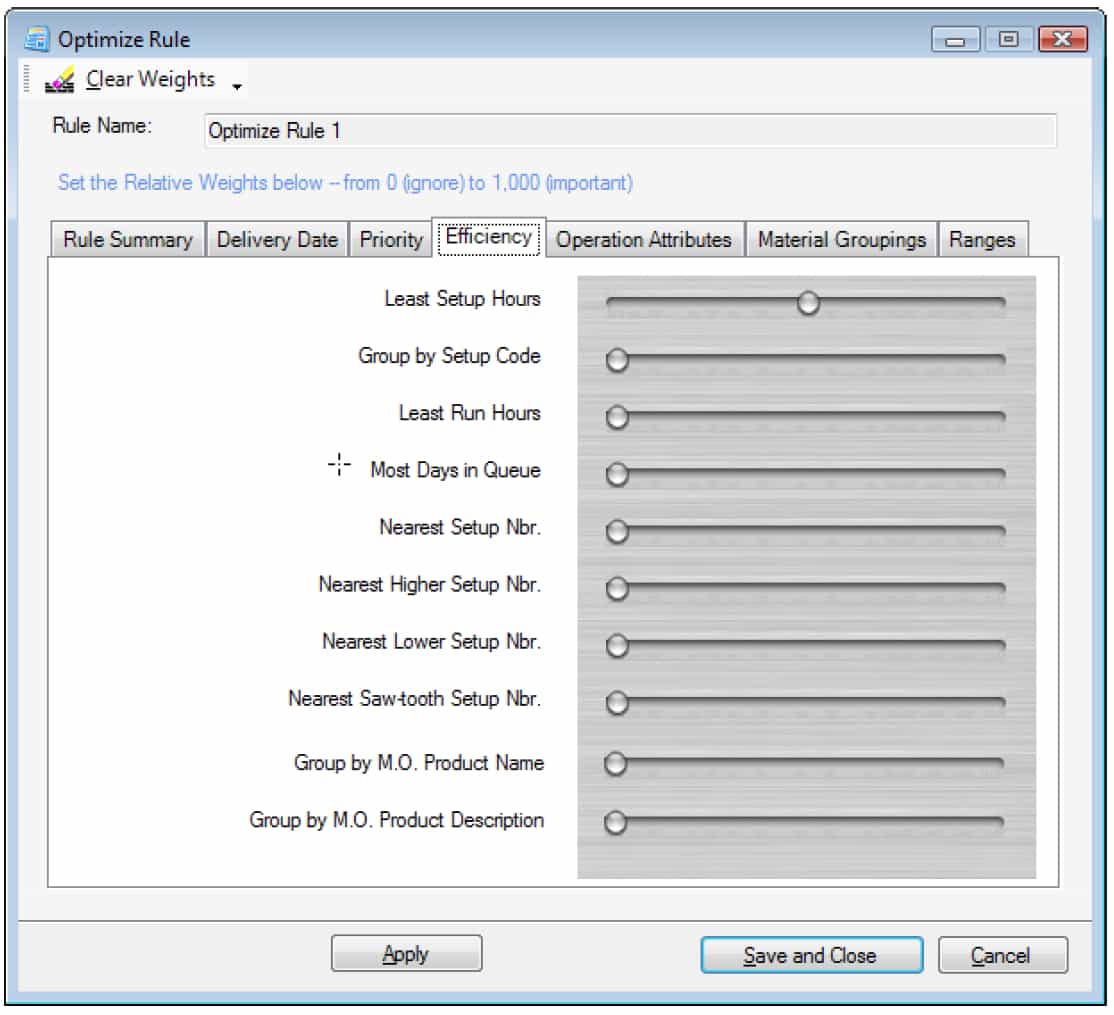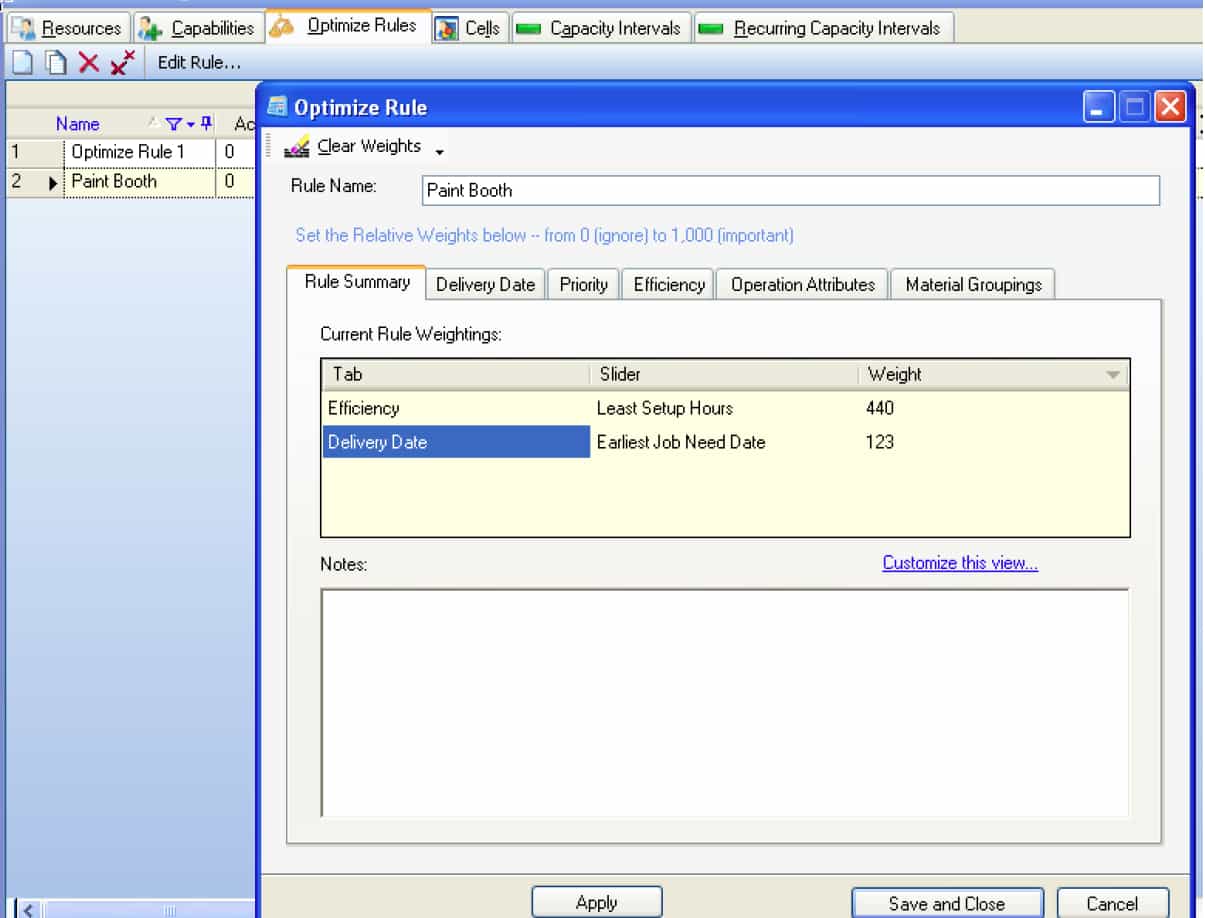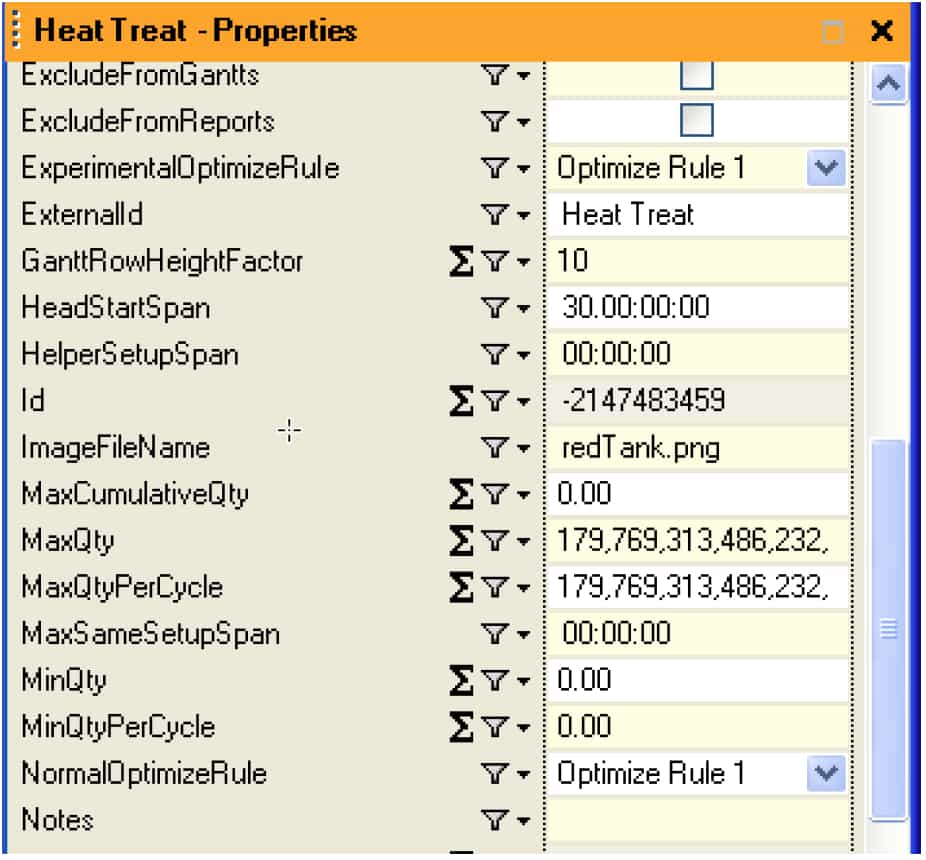Executive Summary
- This is the Brightwork Research & Analysis software rating series.
- We rate both the software and estimate the risk of implementing each application.
MUFI Rating & Risk for PlanetTogether
MUFI: Maintainability, Usability, Functionality, Implement ability
Vendor: PlanetTogether (Select For Vendor Profile)
Introduction
PlanetTogether has created a substantial portion of the overall applied innovation in production planning and scheduling over the past ten years. (We are aware of many of the innovative features in AspenTech, but the statement still holds as much of AspenTech’s innovation was developed over ten years ago.) PlanetTogether is a perfect example of something we repeatedly observe about enterprise software – the most innovation comes from the smallest, not the largest company.
Application Detail
If most buying companies understood how to evaluate enterprise software, PlanetTogether’s would be the most widely deployed production planning and scheduling application. Even many of PlanetTogether’s current customers do not know what the application can do because its functionality is so deep that a buying company may only be deploying a small fraction of PT’s functionality. To provide a good accounting of this application, we have listed the following bullet points:
- The only multi-plant planning application (this means the ability to plan multiple plants as if they are one location) that naturally accounts for lead times between locations.
- Multi-User – any user can plan any plant or groups of plants that they have the authority to plan.
- A leading edge duration based optimizer – combined with the ability to prioritize almost any KPI (that is to adjust the duration optimizer by KPIs – including financial KPIs – meaning PT is the only system allowing production to be optimized with throughput accounting principles). PT has 30+ manufacturing based KPI, including cost & profit KPI that are tracked within and across any number of scenarios.
- Shop floor data collection capabilities.
- Has functionality to use a “synchronous manufacturing” approach with strategic buffer management at key control points to protect against the inevitable variation of manufacturing’s reality.
- PT not only has the best master data management and update capabilities in its software category, but it is also one of the best master data management and update capabilities that we have measured of any enterprise software application.
- PT has our best-rated user interface in its category. It is both easy to use, and scales in that the user learns a great deal as they use it.
- Co-Pilot. PT has developed an automated system for simulation that merely runs in the background when processing is available and comes up with improved solutions. This Co-Pilot functionality can run at any time – and may run intensively overnight testing many different combinations. This is we believe an entirely new concept – and is a huge improvement for the vast majority of companies that lack time to perform simulation through other approaches.
- Subcontracting – while most subcontracting functionality in both ERP and other planning systems is complex and trouble-prone, subcontracting in PT works very smoothly. This in part comes down to a design feature that also makes the application appropriate for multi-plant planning.
- Capable of promising (CTP) – PT is indeed a Swiss Army Knife. In most advanced planning application like APO, Capable to Promise rarely works. However, secondly, it is a separate module – with separate licensing and consulting and maintenance costs. In APO this module is called GATP is and separate from their production planning and scheduling application called PP/DS. However, with PT, CTP is included. In PT, CTP requires minimal configuration or implementation work; it is mostly a natural consequence of simply implementing the application.
PT is an application that can handle many manufacturing environments. It can easily manage discrete and repetitive manufacturing, and can perform “light” process batch and continuous manufacturing planning and scheduling – which we classify as environments like food and beverage, but gives way to AspenTech for “heavy” process batch and continuous industry manufacturing which we classify as anything from petroleum to petrochemical manufacturing.
Optimization rules — or augmentations to the optimization objective function of minimizing duration — can be added. An optimization rule is created by moving sliders in any of the optimization rule categories (Delivery Date, Priority, Efficiency, Operation Attributes, Material Groupings, and Ranges). A combination of all of the sliders makes up an optimization rule, which is then saved. Multiple optimization rules can be created and then assigned to the optimization planning run.
Here you can see the weights that have been applied to each Optimization Rule. You can add any number of Optimization Rules. Beyond that, not only can Optimization Rules be assigned to the overall model, but also to individual Resources as the screenshot below shows.
For this Resource, the Optimization Rule 1 is applied. Also, notice that there is an Experimental Rule. Experimental Rules tend to be used during simulation.
PlanetTogether’s PT is our recommended choice for all but the heavy process industries. Buyers can expect PT to come up quickly, and for the system to have a higher user adoption. Long-term support from PlanetTogether is excellent, and the application is continually growing, meaning buyers will benefit even more in the future from implementing PT.
MUFI Scores
All scores out of a possible 10.
MUFI Scores
- Ma. = Maintainability
- Us. = Usability
- Fu. = Functionality
- Im. = Implementability
| App | Ma. | Us. | Ft. | Im. | Cat. |
|---|---|---|---|---|---|
| Average Score for Big ERP | 5.1 | 4.8 | 5.2 | 5.4 | Big ERP |
| Average Score for CRM | 6.2 | 6.2 | 5.1 | 5.9 | CRM |
| Average Score for Small and Medium ERP | 8.3 | 8 | 6.7 | 8.5 | Small and Medium ERP |
| Average Score for Finance | 8.8 | 8.8 | 8 | 8.8 | Finance |
| Average Score for Demand Planning | 7.6 | 7.2 | 7 | 7.1 | Demand Planning |
| Average Score for Supply Planning | 6.7 | 6.9 | 7 | 6.8 | Supply Planning |
| Average Score for Production Planning | 6.8 | 6.9 | 7 | 6.9 | Production Planning |
| Average Score for BI Heavy | 5.5 | 5.3 | 6.9 | 5.3 | BI Heavy |
| Average Score for PLM | 7 | 7.2 | 6.8 | 7.3 | PLM |
| Average Score for BI Light | 7.7 | 8.7 | 9 | 8.3 | BI Light |
| Arena Solutions Arena PLM | 10 | 10 | 10 | 10 | PLM |
| AspenTech AspenOne | 4 | 8 | 10 | 7 | Production Planning |
| Birst | 8 | 8.5 | 10 | 8 | BI Light |
| ERPNext | 10 | 10 | 7.5 | 10 | Small and Medium ERP |
| Delfoi Planner | 8 | 6 | 6.5 | 7 | Production Planning |
| Demand Works Smoothie SP | 9 | 10 | 7 | 10 | Supply Planning |
| Hamilton Grant RM | 10 | 9 | 8.5 | 9 | PLM |
| IBM Cognos | 2.7 | 3 | 1.5 | 3 | BI Heavy |
| Infor Epiphany | 7 | 8 | 6 | 5 | CRM |
| Infor Lawson | 8 | 7 | 6 | 7 | Big ERP |
| Intuit QuickBooks Enterprise Solutions | 9 | 9 | 5 | 9 | Finance |
| JDA DM | 9 | 7.5 | 8 | 8 | Demand Planning |
| Microsoft Dynamics CRM | 2 | 3 | 2 | 2 | CRM |
| NetSuite CRM | 6 | 4 | 3 | 3 | CRM |
| Netsuite OneWorld | 7 | 7 | 8 | 8 | Big ERP |
| OpenERP | 7 | 8 | 8.5 | 8 | 7 |
| Oracle BI | 4 | 4 | 3 | 6 | BI Heavy |
| Oracle CRM On Demand | 4 | 5 | 3 | 5 | CRM |
| Oracle Demantra | 5 | 3 | 3.5 | 4.5 | Demand Planning |
| Oracle JD Edwards World | 4 | 1 | 3 | 6 | Big ERP |
| Oracle RightNow | 6 | 7 | 4 | 5 | CRM |
| PlanetTogether Galaxy APS | 10 | 10 | 10 | 10 | Production Planning |
| Preactor | 8 | 7 | 3 | 7 | Production Planning |
| QlikTech QlikView | 9 | 9 | 10 | 9 | BI Light |
| Rootstock | 9 | 8 | 9 | 9 | Small and Medium ERP |
| Sage X3 | 8 | 8 | 7 | 8 | Big ERP |
| Salesforce Enterprise | 8 | 8.5 | 9 | 7.5 | CRM |
| SAP APO DP | 3 | 4 | 3 | 2 | Demand Planning |
| SAP APO PP/DS | 2 | 2 | 4 | 3 | Production Planning |
| SAP APO SNP | 3 | 4 | 8 | 4 | Supply Planning |
| SAP BI/BW | 1.5 | 2 | 4 | 2 | BI Heavy |
| SAP Business Objects | 3 | 2.5 | 7 | 3 | BI Heavy |
| SAP CRM | 4 | 3 | 6 | 4 | CRM |
| SAP ECC | 3 | 3 | 6.5 | 3 | Big ERP |
| SAP PLM | 1 | 2.5 | 2 | 3 | PLM |
| SAP SmartOps | 4 | 4 | 7 | 5.5 | Supply Planning |
| SAS BI | 6.5 | 7 | 9 | 6 | BI Heavy |
| SAS Demand Driven Forecasting | 7 | 8 | 9 | 7 | Demand Planning |
| Tableau (BI) | 9 | 10 | 10 | 10 | BI Light |
| Tableau (Forecasting) | 10 | 8 | 5 | 9 | Demand Planning |
| Teradata | 8 | 6.3 | 9.7 | 6 | BI Heavy |
| ToolsGroup SO99 (Forecasting) | 7 | 8 | 9 | 7 | Demand Planning |
| ToolsGroup SO99 (Supply) | 5 | 6 | 10 | 7 | Supply Planning |
Vendor and Application Risk
Buyers of PT have every possible advantage working their direction. PT is one of the highest rated applications we have ever rated. It is a rare situation where a buyer has the opportunity to purchase software that is both the functionality leader in its category, along with being highly implementable and user-friendly.
Likelihood of Implementation Success
This accounts for both the application and vendor-specific risk. In our formula, the total implementation risk is application + vendor + buyer risk. The buyer specific risk could increase or decrease this overall likelihood and adjust the values that you see below.
Likelihood of Application Implementation Success and Failure
Search for the application in this table using the search bar in the upper right of the table.
| Application | Prob of Implementation Success | Prob of Implementation Failure |
|---|---|---|
| Actuate | 0.77 | 0.23 |
| SAP Smartops | 0.39 | 0.61 |
| NetSuite CRM | 0.46 | 0.54 |
| Sugar CRM | 0.62 | 0.48 |
| Base CRM | 0.91 | 0.09 |
| SAP CRM | 0.35 | 0.65 |
| Salesforce Enterprise | 0.72 | 0.28 |
| QlikTech QlikView | 0.82 | 0.18 |
| Tableau (BI) | 0.98 | 0.02 |
| SAP Crystal Reports | 0.46 | 0.54 |
| Brist | 0.83 | 0.17 |
| MicroStrategy | 0.7 | 0.3 |
| SAS BI | 0.76 | 0.24 |
| Oracle BI | 0.35 | 0.65 |
| IBM Cognos | 0.23 | 0.77 |
| Infor Epiphany | 0.58 | 0.42 |
| Microsoft Dynamics CRM | 0.26 | 0.74 |
| Oracle RightNow CRM | 0.41 | 0.59 |
| Oracle CRM On Demand | 0.36 | 0.64 |
| Teradata | 0.76 | 0.24 |
| SAP Business Objects | 0.32 | 0.68 |
| SAP BI/BW | 0.25 | 0.75 |
| SAP PLM | 0.29 | 0.71 |
| Hamilton Grant RM | 0.89 | 0.11 |
| Arena Solutions | 0.96 | 0.04 |
| Delfoi Planner | 0.7 | 0.3 |
| Preactor | 0.64 | 0.36 |
| PlanetTogether Galaxy APS | 0.96 | 0.04 |
| AspenTech AspenOne | 0.55 | 0.45 |
| SAP APO PP/DS | 0.27 | 0.73 |
| Demand Works Smoothie SP | 0.93 | 0.07 |
| ToolsGroup SO99 (Supply) | 0.82 | 0.18 |
| Demand Works Smoothie | 0.96 | 0.04 |
| Tableau (Forecasting) | 0.9 | 0.1 |
| SAS Demand Driven Forecasting | 0.82 | 0.18 |
| ToolsGroup SO99 (Forecasting) | 0.86 | 0.14 |
| JDA DM | 0.57 | 0.43 |
| Oracle Demantra | 0.33 | 0.67 |
| SAP APO DP | 0.28 | 0.72 |
| FinancialForce | 0.92 | 0.08 |
| Intacct | 0.98 | 0.02 |
| Intuit QB Enterprise | 0.8 | 0.2 |
| ERPNext | 0.9 | 0.1 |
| OpenERP | 0.78 | 0.22 |
| Rootstock | 0.91 | 0.09 |
| ProcessPro | 0.93 | 0.07 |
| Microsoft Dynamics AX | 0.4 | 0.6 |
| SAP Business One | 0.49 | 0.51 |
| Sage X3 | 0.62 | 0.38 |
| Infor Lawson | 0.58 | 0.42 |
| Epicor ERP | 0.4 | 0.6 |
| Oracle JD Edwards World | 0.31 | 0.69 |
| Oracle JD Edwards EnterpriseOne | 0.36 | 0.64 |
| SAP ERP ECC/R/3 | 0.32 | 0.68 |
| NetSuite OneWorld | 0.65 | 0.35 |
Risk Definition
See this link for more on our categorizations of risk. We also offer a Buyer Specific Risk Estimation as a service for those that want a comprehensive analysis.
Risk Management Approach
The only implementation issues that a buyer of PT can expect to fact are the traditional issues that face production planning and scheduling projects. PlanetTogether has tended to be implemented by smaller companies – the only reason being they do not have the brand recognition of being associated with a major software vendor. As such they have become acclimated to having their software implemented in clients with quite limited resources. However, they have recently completed a 28 plant implementation and this has demonstrated PlanetTogether’s ability to handle larger clients.
We predict PlanetTogether will eventually be recognized for its excellent software and will become a significantly bigger company and will be implemented by larger buyers, buyers with much more resources. A PT implementation is one that any project manager should look forward to, as it has a high likelihood of adding significant value to the buyer.
Finished With Your Analysis?
To go back to the Software Selection Package page for the Production Planning software category. Or goto this link to see other analytical products for PlanetTogether.



